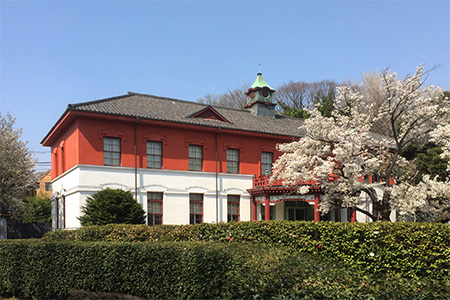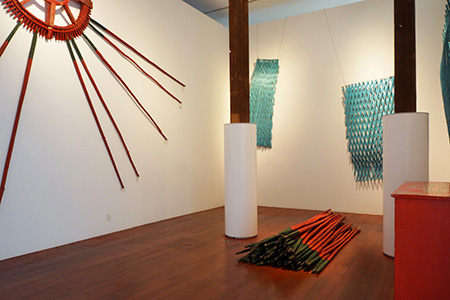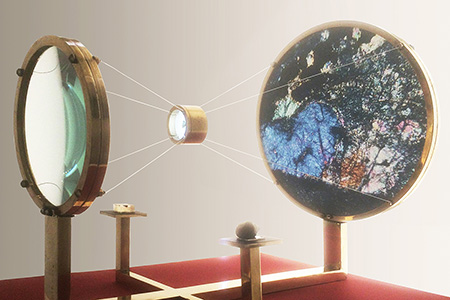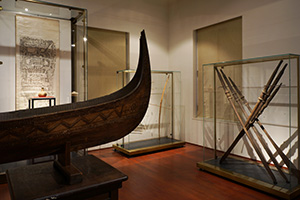


The Former Tokyo Medical School, 1876
Plan of the reconstruction, 1911

The Koishikawa Annex, the University Museum,
the University of Tokyo, 2001-

Architectural Models
Historic Buildings of the University of Tokyo

Body Space (Ger)

Diverse Natural Forms
Spatial Specimens

Body Space (Canoe)
The intention of the exhibition is to expand the concept of architecture through the use of academic resources. From the world of miniaturized models to that of life-sized spaces around the body, and from the world of modeled architectural materials to that of collected ethnological materials, the Koishikawa Annex will embrace the varied worlds that exist within the concept of architecture. Our aim is to organize the principles that structure objects and integrate various phenomena under the umbrella term of "architecture," and to use this higher-order perspective to tie together the natural and artificial, as well as science and art, within the walls of our institution. The actual exhibits are divided into six themes: architectural models, the historical buildings of the University of Tokyo, the diversity of natural forms, spatial specimens, world architecture, and body space.
1. The Main Building of the Former Tokyo Medical School
(Designated Important Cultural Property)
The Koishikawa Annex is the oldest extant school building at the University of Tokyo and is a valuable historical example of the pseudo Western-style architecture of the early Meiji Period. The main building of the former Tokyo Medical School, which later became the Koishikawa Annex, was built on the Hongo Campus by the Building and Repairs Section of the Medical School and the Ministry of Education in 1876. In 1877, the Tokyo Kaisei School and the Tokyo Medical School merged to create the University of Tokyo. Accordingly, the main building became a core facility for the department of medicine. As part of the reorganization of the university hospital, the front half of the building was transported to a location adjacent to the Akamon Gate, and the building was occupied by the Historiographical Institute. The plans for the transfer and reassembly were drawn up by Kokichi Yamaguchi, an engineer at Tokyo Imperial University. In addition to reducing the scale of the building, his redesign, which included a tower, window frames, handrails, and other elements, gave the building its current appearance. It was dismantled in Hongo in 1965, and in 1969, it was reassembled at its present location in the botanical garden operated by the University of Tokyo Graduate School of Science, in Koishikawa. The building was designated an Important Cultural Property in 1970, and has been open to the public as the Koishikawa Annex of the University Museum since November 2001. Although the building was transported and renovated several times, parts of the original design can still be seen in its mix of Western, Chinese, and Japanese styles. This blend of tradition and modernity is especially noticeable in aspects of the building such as its classical proportions, central tower and portico, Wagoya structure, restored entablature, Giboshi balustrade, air-conditioned core, and the modern detailing on the handrails on the staircase.
2. Architectural Models
The steel display cases, which originally belonged to the specimen room of the Faculty of Medicine and date back to the early Showa Era, house miniature models of world-famous architectural structures. The architectural models were originally created for the special exhibition "UMUT Openlab: A Museum City of Architectural Models" in 2008/2009, and the collection has since been expanded. The first group consists of models of modern museum buildings. The collection of 1:300 scale models includes buildings constructed in the prototypical museum style, which is based on the classical aesthetic, those designed using the versatile style made famous by White Cube, and more individualistic contemporary museums. The second group consists of a range of non-museum structures spanning the ancient to modern eras. These include contemporary structures famous both nationally and internationally that range in type from residential buildings to public facilities. The models are built to various scales including 1:50, 1:100, and 1:300, according to the size of the modeled building, with each display case including models of only a single scale for ease of comparison.
3. Historic Buildings of the University of Tokyo
This display includes historic school buildings constructed on the Hongo Campus in the Meiji and Taisho Eras. These include the Legal Medicine Department Building of the Tokyo Imperial University Medical College, the Autopsy Room of the Department of Legal Medicine at the Medical College, the Naval Architecture, Weaponry, and Civil Engineering Department Building of the Tokyo Imperial University Technical College, the Zoology, Geology, and Mineralogy Department Building of the Tokyo Imperial University College of Science, the Main Building of the former Tokyo Medical School, and the Lecture Hall of the Tokyo Imperial University College of Law. Of these, all of the buildings except for the Main Building of the former Tokyo Medical School (currently the Koishikawa Annex) collapsed during the Great Kanto Earthquake of 1923, and do not currently exist. These elaborate 1:100 scale wooden models were produced by the late Giovanni Sacchi, renowned as the best woodworker in Italy, and his workshop. They are based on architectural drawings kept in the Headquarters Facilities Department. These works form part of the legacy of Mr. Sacchi, who was regarded as the foremost inheritor of Italy's long tradition, dating back to the Renaissance Era, of wooden model building.
4. Body Space (Ger)
The body space exhibit rooms containing ethnographic specimens focus on actual components used in movable ethnic architecture. These life-sized spaces that surround the body serve to help visitors become more aware of the relationship between our bodies and the architectural space we inhabit. Gers (collapsible shelters) from Inner Mongolia are designed to meet the needs of a nomadic lifestyle, and can be easily dismantled and reassembled once you learn the technique. The constant movement of the nomadic life would seem, at first glance, to contradict the ideas of well-grounded architectural structures, yet if we accept that the mobility of structures and the minimal use of materials are important challenges in modern architecture, there may be many things that the nomadic view of architecture can teach us.
5. Diverse Natural Forms
This exhibit draws from the diverse academic fields of zoology, botany, mineralogy, and mathematics to display real and model objects that make up a kind of "natural architecture." For this exhibit, the selection includes crystal models manufactured by the Krantz Company in Germany, molluscs including specimens of the Pacific sundial (Architectonica trochlearis (Hinds, 1844)), and assorted mathematical models including of polyhedra, spirals, knots, and tori. These specimens show the beauty of various forms and provide plenty of hints for good architectural design.
6. Spatial Specimens
This exhibit features architectural models that are especially large or have distinctive interior spaces. These include the Basilica of Sant'Andrea (Leon Battista Alberti), known for its elaborate facades and imposing interior spaces, the Pureland Hall of Jyodoji Temple (Shunjobo Chogen), a leading example of Daibutsuyō architecture, the Fallingwater House (Frank Lloyd Wright), which was built on a mountain stream, the Villa Almerico-Capra (Andrea Palladio), which sought to achieve perfect symmetry, the Notre Dame du Raincy (Auguste Perret), which successfully created a Gothic space out of concrete, the Hedmark Museum (Sverre Fehn), in which a new structure was superimposed on historical ruins, and the Hagia Sophia of Istanbul, which represents the pinnacle of the great Byzantine domes. In addition, steel window frames from the former Tokyo Central Post Office were used to construct the legs of the display case.
7. Body Space (Canoe)
The body space exhibit rooms containing ethnographic specimens focus on actual components used in movable ethnic architecture. These life-sized spaces that surround the body serve to help visitors become more aware of the relationship between our bodies and the architectural space we inhabit. A canoe used by the Yami people of Taiwan, shown here together with three sets of oars, can be thought of as an example of water-borne architecture. The exhibition case contains various objects that come in contact with the body, including those from the periphery to the exterior of architectural structures.
8. Photographs of the University of Tokyo Campus
The photographs arranged in various places in the hall are a subset of one of the main collections at the Koishikawa Annex. These were selected from among 3,282 glass photographic plates housed in the former warehouse of Tokyo Imperial University, and depict the construction of the University of Tokyo. The photographs were taken under the direction of architect Yoshikazu Uchida (1885-1972) who, as a professor in the engineering department, oversaw the rebuilding of the university after the Great Kanto Earthquake, and later became president of the University of Tokyo.
Top page of ARCHITECTONICA